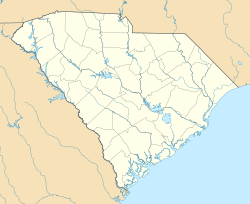Millwood (Richland County, South Carolina) facts for kids
Quick facts for kids |
|
|
Millwood
|
|
| Location | 6100 Garner's Ferry Road |
|---|---|
| Nearest city | Columbia, South Carolina |
| Built | ca. 1830 |
| Architect | Nathaniel Potter (renovation) |
| Architectural style | Greek Revival |
| NRHP reference No. | 71000803 |
| Added to NRHP | March 18, 1971 |
Millwood is the remains of a large plantation house. It was located near Columbia, South Carolina. The house belonged to Colonel Wade Hampton II and his wife Ann Fitzsimmons Hampton. It was also the childhood home of their son, Wade Hampton III. He later became a famous general and politician.
After Wade Hampton II died in 1858, his four unmarried daughters inherited the house. In 1865, during the American Civil War, General William Tecumseh Sherman's troops burned Millwood. This happened when they also burned the city of Columbia. The ruins of Millwood were added to the National Register of Historic Places in 1971.
Contents
The Hampton Family History
The Hampton family was very important in South Carolina. They owned many large farms called plantations.
Wade Hampton I: A Revolutionary Hero
Wade Hampton I (1752–1835) was a brave soldier. He fought in the American Revolutionary War. He was also a general in the War of 1812. Besides being a soldier, he was a congressman. He was also a very rich farmer. When he died, he owned many plantations. He was one of the wealthiest people in the Southern United States.
Wade Hampton II: A Leader and Sportsman
Wade Hampton II (1791–1858) was known as "Colonel." This was because he was an officer in the South Carolina Militia. He served two terms in the South Carolina Senate. Even though he did not seek other political jobs, he was very important in state politics. He loved sports, hunting, and raising horses.
Wade Hampton III: Soldier and Governor
Wade Hampton III (1818–1902) was the first son of Wade Hampton II. He joined the Confederate Army during the Civil War. He led a group called Hampton's Legion. He rose to become a high-ranking general. After the war, he became the first Democratic governor of South Carolina. He was later elected as a U.S. Senator.
Millwood's Grand Design
Millwood was a very impressive house. It was built around 1830. Many old houses grew over time, so it might have been expanded.
Early Construction and Remodeling
Wade Hampton II married Ann Fitzsimons in 1817. His father gave him land for Millwood. Wade Hampton II first built a two-story cottage. This was before his son, Wade Hampton III, was born in 1818.
In 1837 or 1838, Millwood was greatly changed. It was remodeled in the Greek Revival style. This style was popular for grand homes. The architect was Nathaniel Potter from Rhode Island. His design added a wing on each side of the house. It also had six tall columns in the middle. There were three smaller columns on each wing. The changes took about two years to finish.
What Millwood Looked Like
Pictures and descriptions show how grand Millwood was. The central part of the house had two stories. It had a large porch with six columns. On each side were one-story wings. These wings also had three columns each. The central part of Millwood looked like another famous house. This house was Millford Plantation, built by Hampton's sister. Both houses were designed by the same architect, Nathaniel Potter.
Inside Millwood's First Floor
A possible layout of Millwood's first floor has been described. It had a main hall in the center. There were two rooms on each side at the front of the house. These rooms had wide folding doors. This meant the whole front of the house could be opened up. This was perfect for parties and dancing. A hall behind these rooms connected to the wings. A curving staircase led to the second floor.
Millwood's Role in South Carolina Society
Millwood was a very important place for social gatherings. It was called the "social center of South Carolina" before the Civil War. Many important people visited Millwood. This included politicians, wealthy landowners, and leading families from South Carolina. Famous national guests like Henry Clay and Daniel Webster also visited.
In 1844, the party for Governor William Aiken, Jr. was held at Millwood. This shows how important the house was.
The Burning of Millwood in 1865
During the Civil War, Millwood faced a sad end.
Saving Valuables and the Fire
Before General Sherman's troops arrived, the Hampton family saved their valuable items. They moved their silver, china, and family portraits to York, South Carolina. This kept them safe. However, many Hampton family plantations were burned. This included Millwood. There is no clear proof that Sherman ordered this. But the houses were far from downtown Columbia. So, they were probably burned on purpose. The Hampton–Preston House in Columbia was saved.
What Remained of Millwood
After the fire, only parts of Millwood were left. The twelve columns, the smokehouse, and part of the stable remained. Later, the six shorter columns from the wings were taken down. Around 1930, one of the round columns fell. Today, only its base, three other round columns, and two square columns are left.
The Hampton daughters built a small house nearby after the war. This house was also burned down later. This happened after a tough election in 1876, which Wade Hampton III won. They then built a new two-story house. They used the old kitchen and laundry buildings near the ruins of Millwood.
Images for kids




